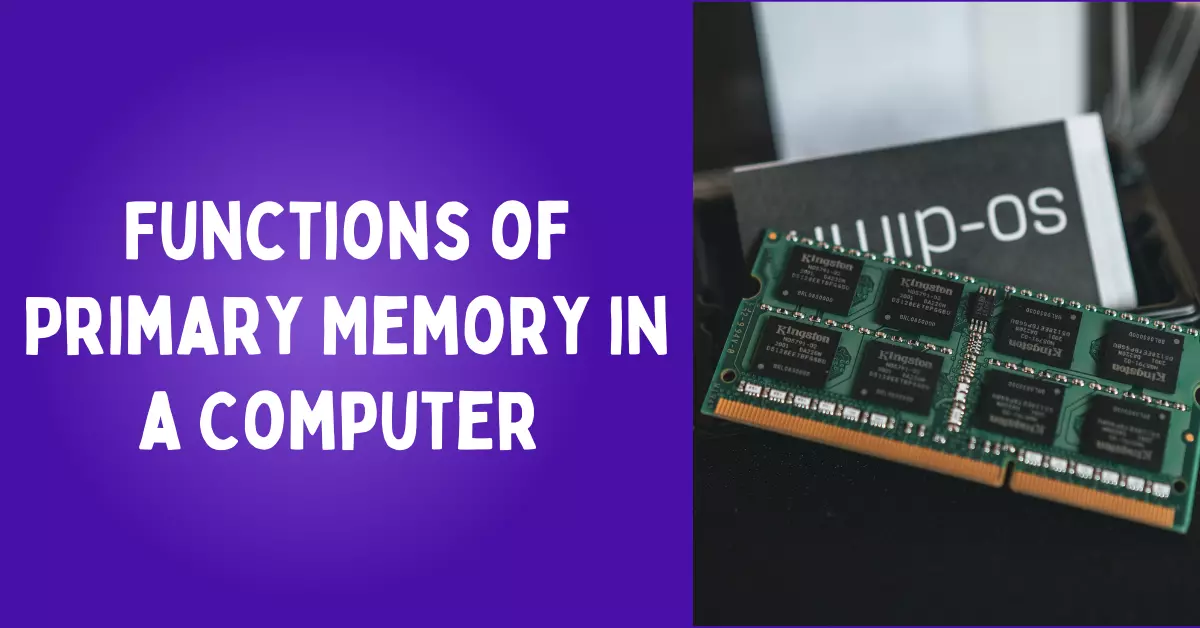Computer memory is the most important part or device of the computer system which is included as the core computer architecture.
The computer system cannot work when memory is absent in the system.
The computer memory is used to store data and information temporarily and permanently.
In today’s post, we are going to learn and describe what are the 4 functions of primary memory in computer systems.
What is Primary Memory in Computer?
The primary memory in a computer is considered to be a volatile memory. The term volatile memory can be described in simple words as follows.
The data and instructions are lost from the memory when there is a power loss and we cannot retrieve the data after the power interruption.
They are also “Read Only Memory” and they cannot store or hold data and instructions permanently and are therefore known as “Temporary Memory”.
The data is lost when there is a power failure and the data is unable to recover or restore.
The primary memory of computer systems is also called “Internal Memory” or “Main Memory”.
The data access and transfer speed are incredible for the primary memory of computers and hence it is considered to be a major advantage.
The data storage of primary memory (RAM, ROM) is limited compared to secondary memory of computer systems such as hard disk and SSD drives.
These primary memories are comparatively more expensive than secondary memory.
They are also known as “Semiconductor Memory”.
The primary memory is responsible for providing the data and instructions to the CPU {Central Processing Unit} for further processing.
One of the major tasks of primary memory is to hold the current data and instruction presented to them.
This memory is faster, small in size, lighter, and consumes less power compared to other memory like secondary memory.
They are very essential memories of a computer and if they are removed from the computer system it fails to start or boot normally.
Each and every computer needs a primary memory to work and function properly.
4 Functions of Primary Memory in a Computer System
- Primary memory directly communicates with CPU {Central Processing Unit}.
- The data and instructions are stored in memory for further processing.
- The primary memory or main memory holds data and instructions temporarily and forwards the task for further operations to the CPU.
- The main memory is responsible to hold the data and tasks currently needed for processing.
- When the operating system loads itself then the primary memory of the computer system holds all the major applications of OS.
- Primary Memory runs user-installed application software as well as crucial and very important files into the system.
Characteristics of Primary Memory
- They are called Main Memory.
- They are fast when compared to the secondary memory of computer systems.
- They are volatile memory.
- They are quite more expensive than their counterparts.
- They can be accessed directly with the CPU {Central Processing Unit}.
- Every computer system needs primary memory to function properly.
- The data and instructions transfer speed is excellent.
- They are also called as “Semiconductor Memory”.
- They are Read Only Memory once the data is lost and cannot be recovered or restored.
- They are very important memory of computer system & computer cannot function properly without their use.
Related Articles
- Different Types of Secondary Memory in Computer
- What is a Computer Memory Definition and Their Types
- Advantages and Disadvantages of Cache Memory
- Types of Floppy Disks in Computer
- 12 Examples of Secondary Memory in Computer Systems
- Is Floppy Disk a Secondary Device in Computer Storage
- What is Buffered Memory and Their Differences
- Characteristics of Virtual Memory in Computer
- Differences Between Internal And External Memory
- 13+ Characteristics of Primary Memory
- What is Volatile Storage Devices
- 5 Functions of Software in Computer
- Learn Computer Fundamentals
- Computer Basic Tutorials
What are the Types of Memory?
There are three types of memory in computer
- Main Memory or Primary Memory.
- Secondary Memory.
- Cache Memory.
What are the Examples of Primary Memory?
- RAM
- ROM
- SDRAM
- DRAM
- SRAM
- PROM
- EPROM
- EDO RAM
- DDR SDRAM
Get In Touch
I have also written and compiled some articles on computers and telecommunications, and please go through them.
I hope you will like reading it.
I hope that all the questions and queries related to 4 Functions of Primary Memory in a Computer System have been answered here.
Don’t hesitate to contact me, and if you need to add, remove, or update anything from the article, please let me know in the comment section or via email.
I will be more than happy to update the article. I am always ready to correct myself.
I was hoping you could share this article with your friends and colleagues; this motivates me to write more on related topics.
!!! Thank You !!!
